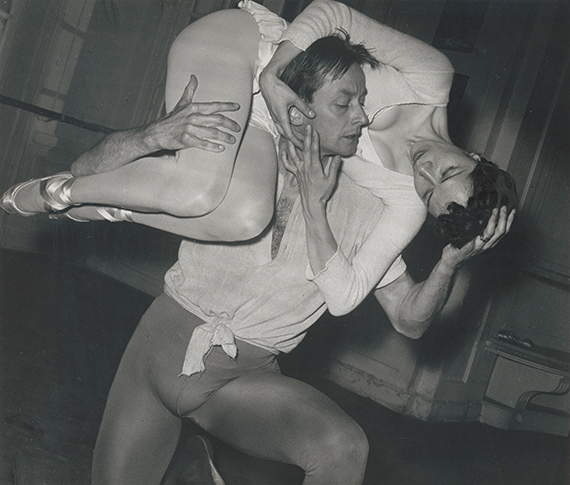
Die Tänzerin Elsa Krüger, 1922
Silbergelatine, 22,5 x 15,5 cm
OÖLKG, Land Oberösterreich, Fotosammlung
Madame d'Ora (Dora Kalmus) »
Elegance and eccentricity
Eleganz und Exzentrik
Exhibition: 5 Dec 2024 – 9 Mar 2025
Wed 4 Dec 19:00

Ballett des Marquis de Cuevas, 1950–1957
Silbergelatine, 27,2 x 33,2 cm
OÖLKG, Land Oberösterreich, Fotosammlung
Dora Kallmus (1881–1963), also known as Madame d'Ora, is one of the most important photographers of the early 20th century. From 1907 onwards, she ran a studio in Vienna under the brand name d'Ora, which was frequented by illustrious personalities from the aristocracy, art and society, and quickly became the first address for artistic portrait photography. Inspired by art photography around 1900, she created images that radiate elegance and individuality and reflect the prevailing zeitgeist.
As one of the first fashion photographers, she documented the clothing creations of the Wiener Werkstätte and portrayed the fashion entrepreneur and style icon Emilie Flöge. The splendid portraits of the Hungarian high aristocracy that Dora Kallmus photographed in 1916/17 on the occasion of the coronation of Emperor Charles as King of Hungary show in a unique way the splendor of an era that is coming to an end.
The exhibition, which exclusively includes the photographer's own collection, spans the period from her early days in Vienna to the later phases of her work, which she lived in Paris from 1925 onwards. In Paris, Dora Kallmus portrayed stars such as Josephine Baker and Ida Rubinstein, created glamorous fashion photographs and worked on the consistent further development of her photographic style. The experience of persecution and loss during the Second World War ultimately shaped the photographer's later work. The glamorous mixed with morbid aspects to create a new artistic visual language that found expression in photographs of animal carcasses in Parisian slaughterhouses.
Curated by Gabriele Hofer-Hagenauer

Emilie Flöge in einem Kleid aus dem Salon „Schwestern Flöge“, 1908
Silbergelatine, 21 x 15,6 cm
OÖLKG, Land Oberösterreich, Fotosammlung
Dora Kallmus (1881–1963), auch bekannt als Madame d’Ora, zählt international zu den bedeutendsten Fotograf:innen des frühen 20. Jahrhunderts. Unter dem Markennamen d’Ora führt sie ab 1907 ein Atelier in Wien, das von illustren Persönlichkeiten aus Aristokratie, Kunst und Gesellschaft frequentiert wird, und rasch zur ersten Adresse für künstlerische Porträtfotografie aufsteigt. Inspiriert von der Kunstfotografie um 1900 entstehen Aufnahmen, die Eleganz und Individualität ausstrahlen und den herrschenden Zeitgeist widerspiegeln.
Als eine der ersten Modefotograf:innen dokumentiert sie die Kleiderkreationen der Wiener Werkstätte, und porträtiert die Modeunternehmerin wie Stilikone Emilie Flöge. Glanzvolle Bildnisse der Ungarischen Hocharistokratie, die Dora Kallmus 1916/17 anlässlich der Krönung Kaiser Karls zum König von Ungarn fotografiert, zeigen in einzigartiger Weise die Pracht einer zu Ende gehenden Epoche.
Die Ausstellung, die ausschließlich eigene Sammlungsbestände umfasst, spannt den Bogen von der Wiener Frühzeit hin zu späteren Werkphasen der Fotografin, die ab 1925 in Paris lebt. Dora Kallmus porträtiert in Paris Stars wie Josephine Baker oder Ida Rubinstein, schafft glamouröse Modefotografien, und arbeitet an der konsequenten Weiterentwicklung ihres fotografischen Stils. Die Erfahrung von Verfolgung und Verlust während des Zweiten Weltkriegs prägt schließlich das Spätwerk der Fotografin. Das Glamouröse mischt sich mit morbiden Aspekten zu einer neuen künstlerischen Bildsprache, die in Aufnahmen von Tierkadavern in Pariser Schlachthöfen ihren Ausdruck findet.
Kuratiert von Gabriele Hofer-Hagenauer

Schuhdetail der Gräfin Erdödy, 1917
Ma OÖLKG, Land Oberösterreich, Fotosammlung
Mattalbumin, 13,4 x 10,2 cm

Abendkleid von Alix, 1935
Silbergelatine, 20,9 x 16,9 cm
OÖLKG, Land Oberösterreich, Fotosammlung
